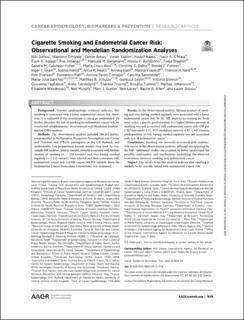| dc.contributor.author | Dimou, Niki | |
| dc.contributor.author | Omiyale, Wemimo | |
| dc.contributor.author | Biessy, Carine | |
| dc.contributor.author | Viallon, Vivian | |
| dc.contributor.author | Kaaks, Rudolf | |
| dc.contributor.author | O'Mara, Tracy A. | |
| dc.contributor.author | Aglago, Elom K. | |
| dc.contributor.author | Ardanaz, Eva | |
| dc.contributor.author | Bergmann, Manuela M. | |
| dc.contributor.author | Bondonno, Nicola P. | |
| dc.contributor.author | Braaten, Tonje | |
| dc.contributor.author | Colorado-Yohar, Sandra M. | |
| dc.contributor.author | Crous-Bou, Marta | |
| dc.contributor.author | Dahm, Christina C. | |
| dc.contributor.author | Fortner, Renée T. | |
| dc.contributor.author | Gram, Inger Torhild | |
| dc.contributor.author | Harlid, Sophia | |
| dc.contributor.author | Heath, Alicia K. | |
| dc.contributor.author | Idahl, Annika | |
| dc.contributor.author | Kvaskoff, Marina | |
| dc.contributor.author | Nøst, Therese Haugdahl | |
| dc.contributor.author | Overvad, Kim | |
| dc.contributor.author | Palli, Domenico | |
| dc.contributor.author | Perez-Cornago, Aurora | |
| dc.contributor.author | Sacerdote, Carlotta | |
| dc.contributor.author | Sánchez, Maria-Jose | |
| dc.contributor.author | Schulze, Matthias B. | |
| dc.contributor.author | Severi, Gianluca | |
| dc.contributor.author | Simeon, Vittorio | |
| dc.contributor.author | Tagliabue, Giovanna | |
| dc.contributor.author | Tjønneland, Anne | |
| dc.contributor.author | Truong, Thérése | |
| dc.contributor.author | Tumino, Rosario | |
| dc.contributor.author | Johansson, Mattias | |
| dc.contributor.author | Weiderpass, Elisabete | |
| dc.contributor.author | Murphy, Neil | |
| dc.contributor.author | Gunter, Marc J. | |
| dc.contributor.author | Lacey, Ben | |
| dc.contributor.author | Allen, Naomi E. | |
| dc.contributor.author | Dossus, Laure | |
| dc.date.accessioned | 2023-01-03T07:31:11Z | |
| dc.date.available | 2023-01-03T07:31:11Z | |
| dc.date.created | 2022-11-09T12:19:58Z | |
| dc.date.issued | 2022 | |
| dc.identifier.citation | Cancer Epidemiology, Biomarkers and Prevention. 2022, 31 (9), 1839-1848. | en_US |
| dc.identifier.issn | 1055-9965 | |
| dc.identifier.uri | https://hdl.handle.net/11250/3040427 | |
| dc.description.abstract | Background:
Current epidemiologic evidence indicates that smoking is associated with a lower endometrial cancer risk. However, it is unknown if this association is causal or confounded. To further elucidate the role of smoking in endometrial cancer risk, we conducted complementary observational and Mendelian randomization (MR) analyses.
Methods:
The observational analyses included 286,415 participants enrolled in the European Prospective Investigation into Cancer and Nutrition and 179,271 participants in the UK Biobank, and multivariable Cox proportional hazards models were used. In two-sample MR analyses, genetic variants robustly associated with lifetime amount of smoking (n = 126 variants) and ever having smoked regularly (n = 112 variants) were selected and their association with endometrial cancer risk (12,906 cancer/108,979 controls from the Endometrial Cancer Association Consortium) was examined.
Results:
In the observational analysis, lifetime amount of smoking and ever having smoked regularly were associated with a lower endometrial cancer risk. In the MR analysis accounting for body mass index, a genetic predisposition to a higher lifetime amount of smoking was not associated with endometrial cancer risk (OR per 1-SD increment: 1.15; 95% confidence interval: 0.91–1.44). Genetic predisposition to ever having smoked regularly was not associated with risk of endometrial cancer.
Conclusions:
Smoking was inversely associated with endometrial cancer in the observational analyses, although unsupported by the MR. Additional studies are required to better understand the possible confounders and mechanisms underlying the observed associations between smoking and endometrial cancer.
Impact:
The results from this analysis indicate that smoking is unlikely to be causally linked with endometrial cancer risk. | en_US |
| dc.language.iso | eng | en_US |
| dc.publisher | American Association for Cancer Research | en_US |
| dc.rights | Attribution-NonCommercial-NoDerivatives 4.0 Internasjonal | * |
| dc.rights.uri | http://creativecommons.org/licenses/by-nc-nd/4.0/deed.no | * |
| dc.title | Cigarette Smoking and Endometrial Cancer Risk: Observational and Mendelian Randomization Analyses | en_US |
| dc.title.alternative | Cigarette Smoking and Endometrial Cancer Risk: Observational and Mendelian Randomization Analyses | en_US |
| dc.type | Peer reviewed | en_US |
| dc.type | Journal article | en_US |
| dc.description.version | publishedVersion | en_US |
| dc.source.pagenumber | 1839-1848 | en_US |
| dc.source.volume | 31 | en_US |
| dc.source.journal | Cancer Epidemiology, Biomarkers and Prevention | en_US |
| dc.source.issue | 9 | en_US |
| dc.identifier.doi | 10.1158/1055-9965.EPI-21-1176 | |
| dc.identifier.cristin | 2071168 | |
| cristin.ispublished | true | |
| cristin.fulltext | original | |
| cristin.qualitycode | 1 | |

